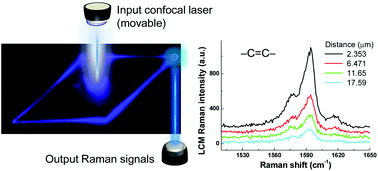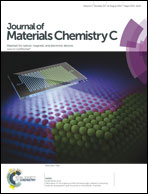Dual-mode waveguiding of Raman and luminescence signals in a crystalline organic microplate†
Abstract
We demonstrate dual-mode waveguiding of Raman and luminescence signals using π-conjugated organic 1,4-bis(3,5-bis(trifluoromethyl) cyanostyryl)-2,5-dibromobenzene (CN-TSDB) microplates with single-crystal structure. The output Raman and photoluminescence (PL) spectra through the CN-TSDB microplates were recorded as a function of propagation distance using a high-resolution laser confocal microscope (LCM). Under 633 nm Raman excitation, which is outside the optical absorption of the microplates, the characteristic Raman modes of C–Br, –CF3, and –C![[double bond, length as m-dash]](https://www.rsc.org/images/entities/char_e001.gif) C– aromatic stretching were clearly observed at the output points. The decay characteristics of the LCM Raman intensities were comparable to those of LCM PL intensities. The intermolecular π–π interaction of CN-TSDB has been enhanced by the attractive interaction between the CN group and Br atoms, which induces efficient polariton propagation and plays an important role in dual-mode waveguiding.
C– aromatic stretching were clearly observed at the output points. The decay characteristics of the LCM Raman intensities were comparable to those of LCM PL intensities. The intermolecular π–π interaction of CN-TSDB has been enhanced by the attractive interaction between the CN group and Br atoms, which induces efficient polariton propagation and plays an important role in dual-mode waveguiding.


 Please wait while we load your content...
Please wait while we load your content...